You’ll revolutionize your jewelry craftsmanship with advanced techniques like En Tremblant’s coiled metal mechanisms that create natural stone movement, and Vitrail Mystery™’s invisible settings that make gems appear to float. Master the Waltzing Brilliance® method for spinning stones that capture light from every angle, while tension settings eliminate visible metal support entirely. These micro-engineering approaches require specialized tools like precision setting burs, microscopes, and temperature-controlled soldering stations. Discover how these sophisticated methods can transform your artistic possibilities.
Mastering En Tremblant and Dynamic Movement Settings

While traditional gem settings focus on security and stability, mastering En Tremblant and dynamic movement settings requires you to embrace the art of controlled motion.
This 18th-century French gemstone setting technique uses coiled metal mechanisms that allow stones to move naturally, creating enchanting visual effects. You’ll find this particularly effective in floral jewelry designs where movement mimics nature.
The modern Waltzing Brilliance® setting, developed by Moiseikin, takes movement further by using single prongs that enable gemstones to spin freely.
Revolutionary Waltzing Brilliance® setting by Moiseikin employs single prongs to create freely spinning gemstones, elevating dynamic jewelry movement to extraordinary new heights.
Both setting techniques demand exceptional precision in your craftsmanship—you must balance functionality with aesthetics while ensuring secure stone placement.
When you master these advanced methods, you’ll create pieces that capture light from multiple angles, transforming static jewelry into dynamic, engaging accessories that mesmerize viewers.
Vitrail Mystery™ Technique for Invisible Stone Suspension
Beyond creating movement in gemstones, you can achieve the ultimate illusion by making stones appear to float entirely without visible support.
Van Cleef & Arpels’ trademarked Vitrail Mystery™ technique revolutionizes traditional bezel setting by utilizing precise buff-topped cuts that allow facet-to-facet placement. This patented 2014 innovation completely eliminates visible metal on both surface and reverse sides.
You’ll maximize light transmission through each stone, creating stunning vitrage effects that enhance brilliance. The engineering requires meticulous gemstone cutting where stones seamlessly connect without traditional metal boundaries.
Unlike conventional setting techniques, this method guarantees gems take center stage by appearing suspended and illuminated.
This sophisticated approach particularly excels in high-end pieces where striking color and light displays matter most, making it invaluable for creating extraordinary jewelry that defies conventional expectations.
Advanced Tension Setting Applications and Variations
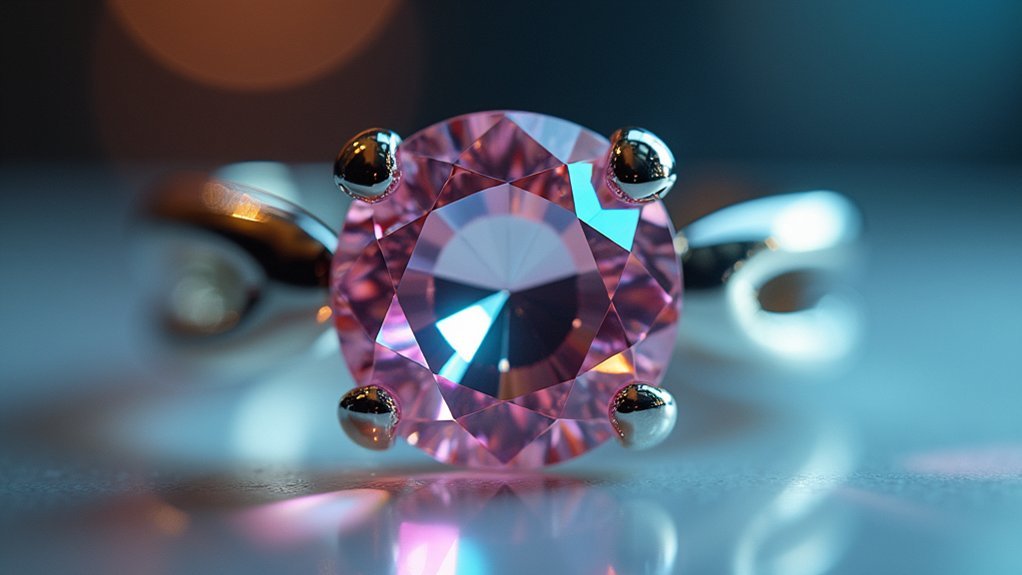
When traditional prongs interfere with your design vision, advanced tension settings release unprecedented possibilities by harnessing the band’s pressure to secure gemstones without visible metal support. You’ll achieve a floating effect that showcases brilliance from every angle while maintaining structural integrity through precise engineering.
| Setting Methods | Material Requirements | Design Capabilities | Examples |
|---|---|---|---|
| Single stone tension | Platinum or strong alloys | Clean, minimalist aesthetic | Classic solitaires |
| Multi-stone interlocking | High-grade metals | Complex arrangements | Wallace Chan’s “My Dreams” |
| Custom shape accommodation | Precision-engineered bands | Varied cuts and sizes | Personalized designs |
| Invisible metal variations | Advanced alloy technology | Seamless stone connections | Contemporary collections |
You’ll need stronger metals like platinum to guarantee durability while creating these innovative pieces that emphasize gemstone beauty through unique cuts and arrangements.
Waltzing Brilliance® Method for Enhanced Light Performance
You’ll master light refraction enhancement by positioning your gemstone’s table at precisely calculated angles within the Waltzing Brilliance® setting.
Your precision angle setting methods must account for the stone’s natural movement while maintaining ideal light entry points through careful prong placement.
You can achieve maximum brilliance by leveraging the dynamic spinning motion that continuously repositions facets to capture and redirect light from multiple directions.
Light Refraction Optimization Techniques
While traditional gem settings prioritize security through multiple contact points, the revolutionary Waltzing Brilliance® method takes an entirely different approach by supporting gemstones with just a single prong positioned beneath the table.
You’ll discover that these light refraction optimization techniques fundamentally transform how your gemstones interact with illumination. This innovative setting technique allows stones to rotate freely, creating continuous movement that exposes every facet to light from countless angles.
You’re maximizing brilliance by minimizing metal interference with the gem’s natural light pathways. The spinning motion generates a mesmerizing dance effect that amplifies sparkle exponentially.
Precision Angle Setting Methods
Since precision determines whether your Waltzing Brilliance® setting achieves its revolutionary light performance, mastering the exact angular positioning becomes critical to success.
You’ll need to calculate the precise angle where your single prong contacts the stone’s table, ensuring ideal rotation while maintaining security. This isn’t your typical prong setting—the dynamic tension requires millimeter-perfect placement to create that signature floating effect.
As an experienced jeweler, you must position the prong at the exact tension point that allows free gemstone movement without compromising stability.
The angle directly affects how light enters and exits the stone, influencing brilliance intensity. Each degree matters when creating the dance-like rotation that defines this Russian innovation.
Master these calculations, and you’ll reveal unobstructed views that showcase exceptional color and clarity.
Maximum Brilliance Achievement Strategies
Perfect angular positioning sets the foundation, but achieving maximum brilliance demands strategic optimization of every light-interaction element within your Waltzing Brilliance® setting.
You’ll maximize light performance by positioning gemstones on a single prong that contacts only the table, creating dynamic movement that amplifies sparkle through continuous repositioning.
This revolutionary gem setting technique eliminates excess metal interference, allowing superior light penetration from multiple angles. As your stones dance and rotate naturally, they’ll capture and reflect light dynamically rather than remaining static.
The minimalist prong design guarantees maximum exposure while maintaining security.
You’ll find this method particularly effective with larger gemstones, where enhanced movement creates dramatic brilliance displays. Each stone becomes a kinetic light performer, transforming traditional static presentations into enthralling, ever-changing exhibitions of fire and scintillation.
Free Movement Setting for Kinetic Jewelry Design
When you’re looking to create jewelry that literally moves with your wearer, the Free Movement Setting offers an innovative solution that revolutionizes traditional gemstone presentation.
Designed by American jeweler Moritz Glik, this technique allows gemstones to move freely between transparent sapphire glass windows, creating dynamic visual effects that shift with each movement.
Unlike conventional settings that secure stones rigidly, you’ll find this kinetic jewelry design doesn’t technically secure gemstones at all.
Instead, the sapphire glass acts as mounting that provides visibility from all angles while maintaining an airy, light appearance.
You’ll achieve pieces that constantly change and evolve, challenging traditional presentation methods and enhancing visual interaction between your jewelry and its wearer through this contemporary approach to gemstone showcasing.
Wallace Chan’s Innovative Tension Setting Approach
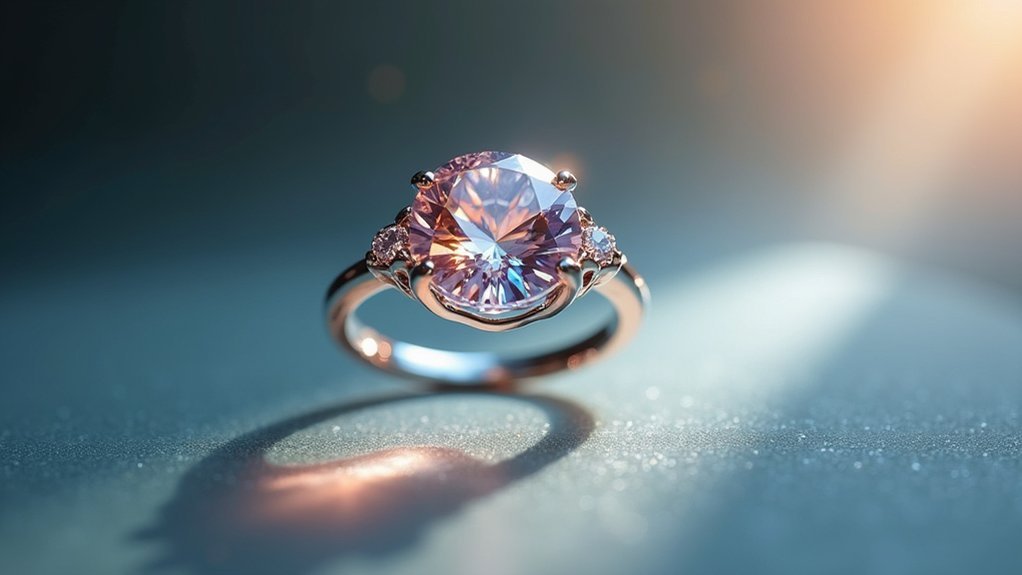
You’ll discover that Wallace Chan’s tension setting technique revolutionizes how gemstones interact through innovative pressure distribution that eliminates traditional metal support.
His sculptural metal engineering creates interlocking systems where carefully cut stones maintain stability through their own weight and precisely crafted shapes.
This approach transforms jewelry into architectural art pieces where gems appear to float in defiance of gravity while maintaining complete security.
Revolutionary Pressure Distribution Methods
While traditional gemstone setting relies heavily on metal prongs and bezels, Wallace Chan’s groundbreaking tension setting technique revolutionizes how pressure distribution across gemstones by eliminating conventional support structures entirely.
You’ll discover that this innovative approach creates secure mounting through strategic pressure points rather than visible metal clasps.
This revolutionary pressure distribution method offers four key advantages:
- Enhanced Light Interaction – Gemstones appear to float, maximizing light penetration and brilliance
- Superior Visual Impact – Eliminates visual obstruction from traditional prongs or bezels
- Optimized Pressure Points – Distributes stress evenly across carefully calculated contact areas
- Increased Stability – Custom gemstone cuts create interlocking mechanisms for superior security
You’ll achieve dramatic visual effects while maintaining structural integrity through Chan’s precision-engineered pressure distribution system.
Sculptural Metal Engineering Techniques
Three-dimensional sculptural forms emerge when Wallace Chan engineers metal frameworks that defy conventional jewelry architecture.
You’ll discover his revolutionary tension setting technique eliminates traditional prongs entirely, using precise gemstone cuts and shapes to lock stones securely without visible metal support. This sculptural metal engineering approach creates surreal, cubist structures that push conventional boundaries while showcasing natural brilliance.
When you examine his My Dreams ring, you’ll see an 11.56ct tourmaline paired with a 9.93ct aquamarine, demonstrating tension setting’s dramatic visual impact.
You can arrange stones in dynamic formations that enhance movement and sparkle, offering unprecedented creative freedom. However, you’ll need meticulous craftsmanship and engineering expertise to guarantee stability and safety.
This stone setting method emphasizes gemstones while requiring exceptional technical precision.
Micro-Engineering Techniques for Ultra-Precise Placement
As precision becomes paramount in contemporary jewelry making, micro-engineering techniques revolutionize how you’ll achieve ultra-precise gemstone placement in your settings.
These advanced methods utilize laser cutting and precision milling to create complex designs with minimal tolerances, ensuring your gemstones surface remains pristine while achieving secure fits.
Laser cutting and precision milling deliver flawless gemstone settings with minimal tolerances while preserving stone integrity and ensuring secure placement.
You’ll benefit from these cutting-edge approaches:
- Computer-aided design (CAD) software that lets you visualize and simulate settings before production
- Specialized adhesives and bonding materials for enhanced security in intricate designs
- Advanced machinery delivering ultra-precise cuts without compromising gemstone integrity
- Innovative artistic possibilities that highlight your stones’ natural beauty through unique expressions
These micro-engineering techniques enable you to create sophisticated pieces where traditional methods fall short, opening new creative possibilities.
Professional Tools and Equipment for Advanced Setting Methods
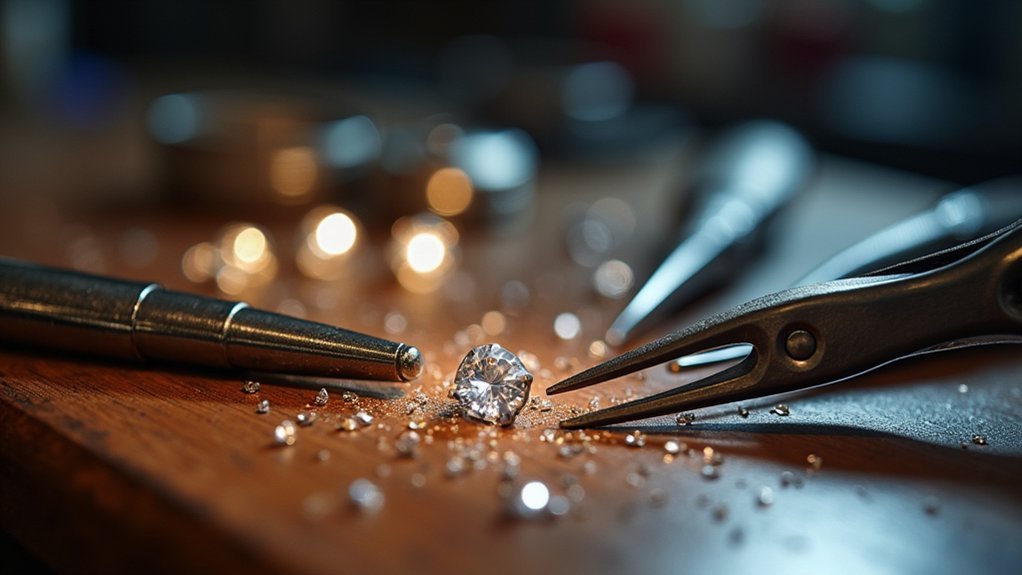
When you’re ready to elevate your gem setting from basic techniques to professional-grade precision, your tool selection becomes the foundation of your success.
Professional tools like setting burs, gravers, and specialized pliers enable you to execute intricate designs with accuracy. You’ll need a quality microscope or magnifying loupe for detailed inspection work, ensuring every stone sits perfectly.
A temperature-controlled soldering station protects delicate gems while securing settings to metal. For advanced setting techniques such as tension and gypsy settings, you’ll require custom tools like tapered setting punches and tube setting implements to achieve proper stone fit.
Don’t overlook essential preparation tools—invest in a quality bench pin, varied files, and sanders for refining metal settings and achieving professional finishes.
Frequently Asked Questions
What Is the Most Secure Gemstone Setting?
You’ll find the bezel setting’s the most secure option for your gemstones. It completely encircles the stone, protecting it from chipping and snagging while preventing loss better than prong or other settings.
What Are the 4 C’s of Gemstones?
You’ll evaluate gemstones using four criteria: Cut determines how well it’s shaped for brilliance, Color measures hue quality, Clarity assesses internal flaws, and Carat indicates weight and size.
How Much Does It Cost to Put a Stone in a Setting?
You’ll pay $50 to $800+ depending on your setting choice. Simple prong settings cost around $50, while bezel settings range $100-$300. Complex designs like pave or custom work can exceed $500.
How to Set a Gem in a Setting?
You’ll select an appropriate setting type, clean and prepare it, carefully position your stone ensuring a snug fit, use specialized tools to secure the metal around it, then polish and inspect for perfection.
In Summary
You’ve explored cutting-edge setting techniques that’ll transform your jewelry craftsmanship. From En Tremblant’s dynamic movement to the mysterious invisible suspension of Vitrail Mystery™, you’re now equipped with professional-grade methods. Master these tension settings, kinetic designs, and micro-engineering approaches to elevate your work beyond traditional standards. With the right tools and Wallace Chan’s innovative techniques, you’ll create pieces that dance with light and movement, setting you apart in today’s competitive jewelry market.


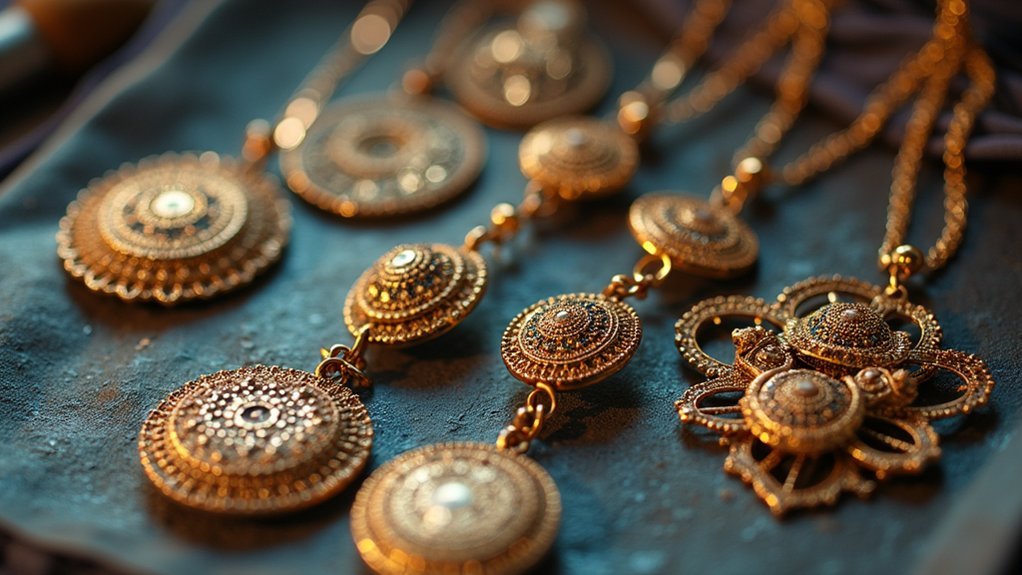
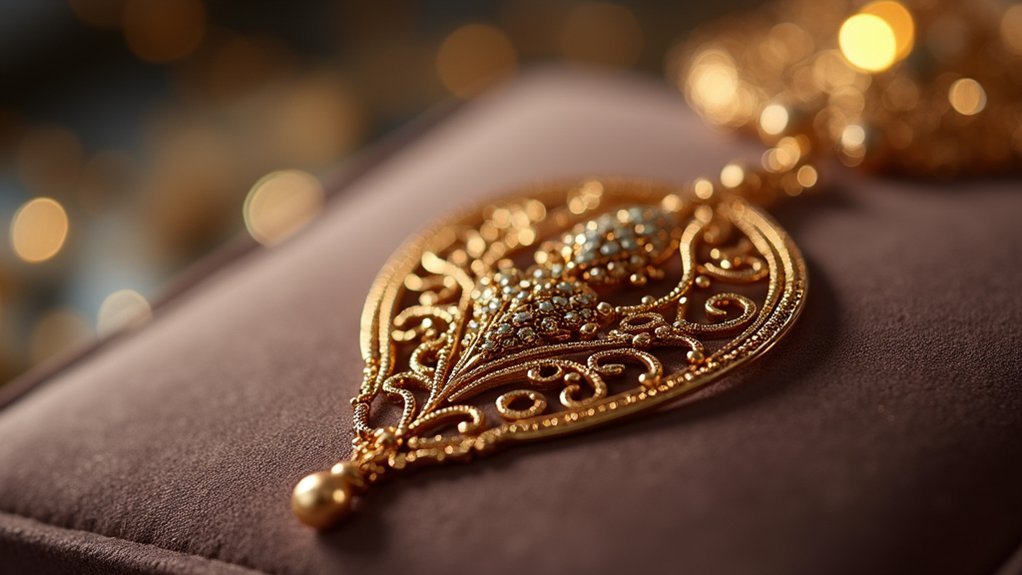

Leave a Reply